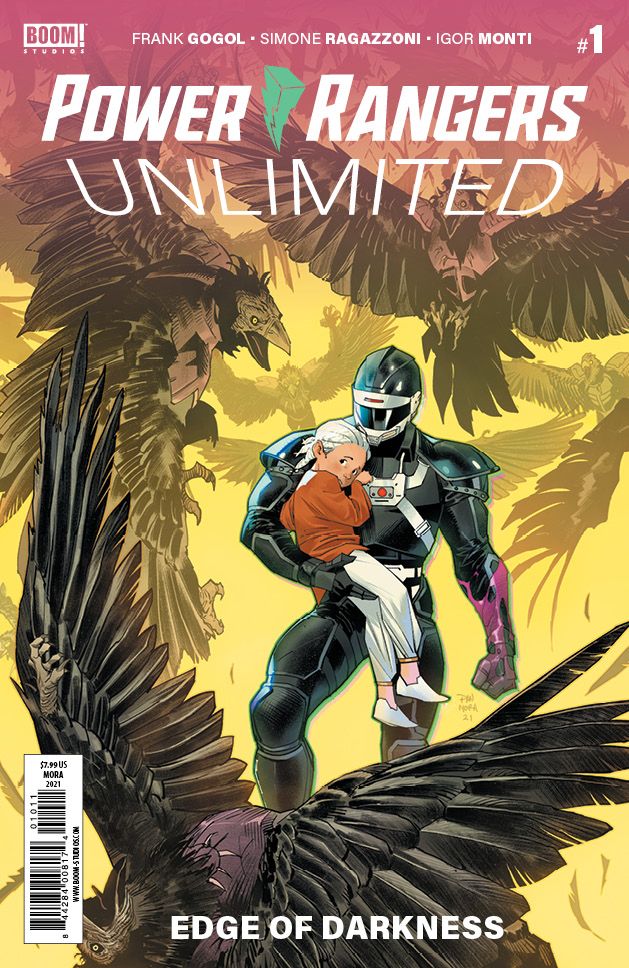
BOOM! Studios is taking an ambitious approach to its Power Rangers license, expanding from a straightforward adaptation to a full-fledged line of books that are dedicated to expanding the Power Rangers universe. Recent series developments have included the introduction of Power Rangers in Space villains Dark Specter, Astronema and Ecliptor and the development of a new team of comics-only Rangers. Written by Frank Gogol and with artwork by Simone Ragazzoni, Power Rangers Unlimited: Edge of Darkness #1 follows the mysterious Phantom Ranger from Power Rangers: Turbo. An entertaining side story that adds to the franchise's lore, Edge of Darkness is a gorgeously drawn adventure that will engage fans of BOOM's ongoing series and draw in readers unfamiliar with the Power Rangers universe.
In Edge of Darkness, the Phantom Ranger is asked by Zordon to look into the destruction of the planet Hartunia -- after the Empyreals destroyed the planet in the latest issue of Power Rangers. As he gazes upon the decimation, Phantom Ranger recalls a past mission to help Zordon and the Guardians of Eltar in their eternal battle against evil, embodied by the ominous Dark Specter. Over 10,000 years ago, Phantom Ranger was tasked with saving Lady Fienna and her daughter Rita from her father, Master Vile, who wanted to find a physical host to bring Dark Specter into the world by using his daughter, Rita. Back in the present, in the wreckage of Hartunia, Phantom Ranger discovers a surprising connection to the Empyreals.
This issue, in particular, depicts how the two ongoing Rangers series have been building toward a single story on parallel paths. Gogol's script primarily focuses on young Rita, who grows up to be the classic Power Rangers villain and her mother. Gogol does not dive in-depth into the Phantom Ranger's origin but he deepens his connection to the Power Rangers and his commitment to Zordon's mission against Dark Specter. The Phantom's doomed mission lends pathos to Rita Repulsa as a character that colors her previous appearances. Gogol writes his story as both a victory and a tragedy, creating a genuinely emotional plot out of some of the silliest elements in Ranger history. By the issue's end, some of the dramatic events from recent Power Rangers issues come together with a renewed sense of dread.
Overall, Ragazzoni's art elevates the narrative. From the issue's opening pages, Ragazzoni slowly builds a sense of scope -- depicting Phantom Ranger as a small figure amid the barren wasteland of the murdered planet. He then slowly zooms in on him over several more panels. Without any facial features, Ragazzoni still effectively captures the Phantom's despair and dread. Ragazzoni carries this kind of panel work throughout the issue, utilizing the layout of the page itself to further the emotional story of its characters while the narrative moves forward. Action scenes are creatively illustrated, with panels that burst out of their grid over one another or morph into sound effects. Igor Monti's colors help emphasize these narrative choices, heightening the mood with his vivid color choices.
While it is a bit heavy on backstory and assumes a level of familiarity with BOOM's ongoing interconnected narrative, Edge of Darkness nonetheless stands alone as a tale of savoring small victories in the face of darkness. Even those unfamiliar with the Rangers' stories will appreciate this sci-fi/fantasy adventure, thanks to Gogol's focus on emotion and Ragazzoni's stellar artwork. The oversized issue elevates the Power Rangers line by upping the emotional stakes and imbuing a level of pathos to even the most surface-level elements of the franchise.
0 Comments